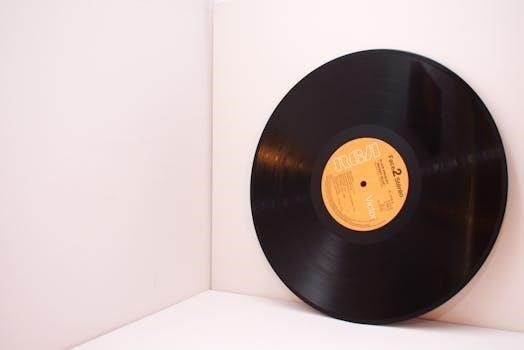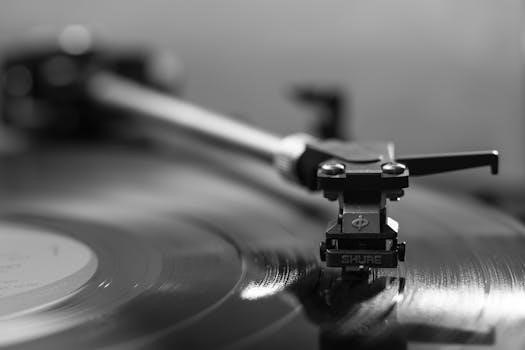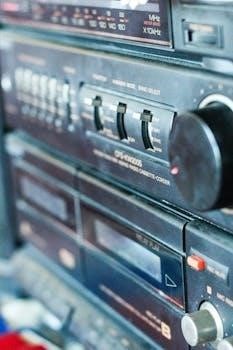Kali Audio LP-6 V2 Manual⁚ A Comprehensive Guide
The Kali Audio LP-6 V2 manual serves as an indispensable resource for users seeking to maximize the potential of their studio monitors. This comprehensive guide offers detailed insights into the features, setup, and operation of the LP-6 V2, ensuring users achieve optimal performance.
The Kali Audio LP-6 V2 represents a significant advancement in studio monitoring technology, designed to empower content creators and audio professionals with the tools needed to achieve exceptional mixes. Building upon the legacy of its predecessor, the LP-6, the V2 iteration introduces a range of improvements aimed at enhancing accuracy, reducing noise, and expanding versatility.
This manual provides a comprehensive overview of the LP-6 V2, guiding users through its features, functionalities, and optimal usage scenarios. Whether you’re a seasoned audio engineer or a budding music producer, understanding the intricacies of the LP-6 V2 is crucial for unlocking its full potential.
The LP-6 V2 distinguishes itself through its advanced waveguide, which facilitates precise 3D imaging, enabling users to pinpoint the placement of instruments and vocals within the stereo field. Its clear sound reproduction across the entire frequency spectrum ensures that every nuance of the audio is faithfully reproduced, while its low-noise performance minimizes unwanted artifacts, resulting in a cleaner and more accurate listening experience. Furthermore, the LP-6 V2’s enhanced sensitivity allows for the creation of punchy and fully realized productions, making it an indispensable asset in any studio environment.
Key Features and Specifications
The Kali Audio LP-6 V2 boasts a comprehensive set of features and specifications that make it a standout performer in the realm of studio monitors. At its core, the LP-6 V2 is a bi-amplified studio monitor, meaning it utilizes separate amplifiers for the woofer and tweeter, resulting in enhanced clarity and headroom.
Equipped with a 6.5-inch woofer and a 1-inch soft dome tweeter, the LP-6 V2 delivers a wide frequency response ranging from 39 Hz to 25 kHz. This extended frequency range ensures accurate reproduction of both low-end frequencies and high-end transients, allowing for precise monitoring of the entire audio spectrum. The monitor incorporates a waveguide design to control sound directivity, widening the sweet spot for optimal listening.
The LP-6 V2 features a Class D amplifier with a power output of 80 watts, providing ample power for dynamic sound sources. Connectivity options include balanced XLR and TRS inputs, as well as an unbalanced RCA input. The monitor also includes boundary EQ controls, allowing users to optimize the sound when the monitor is near a wall or in a corner. The LP-6 V2 operates on a voltage range of 100-240V AC, making it compatible with various power systems.
Understanding the Controls and Inputs
The Kali Audio LP-6 V2 features a straightforward yet versatile set of controls and inputs, allowing for seamless integration into a variety of studio setups. The rear panel of the LP-6 V2 houses the primary controls, including a volume control knob. This knob enables users to adjust the output level of the speaker, ranging from -∞ to +6 dB, with a center detente at 0 dB for a calibrated starting point. Kali recommends setting the volume at the 0 dB detente and adjusting the level from the audio interface or device.
The LP-6 V2 offers multiple input options to accommodate different audio sources. It includes balanced XLR and TRS inputs, providing compatibility with professional audio equipment. Additionally, an unbalanced RCA input is available for connecting consumer-grade devices. These input options ensure flexibility when integrating the LP-6 V2 into various setups.
The boundary EQ settings, accessible via dip switches on the rear panel, allow users to tailor the monitor’s frequency response based on its placement within the room. These settings compensate for acoustic anomalies caused by nearby walls or corners, ensuring accurate sound reproduction.
Connecting the LP-6 V2
Connecting the Kali Audio LP-6 V2 to your audio interface or playback device is a straightforward process. The LP-6 V2 offers versatile connectivity options to accommodate various setups. To begin, identify the appropriate output on your audio interface or computer. The LP-6 V2 accepts balanced XLR and TRS connections, as well as unbalanced RCA.
For balanced connections, use an XLR or TRS cable to connect the corresponding output on your audio interface to the input on the LP-6 V2. Balanced connections are generally preferred as they offer better noise rejection and signal integrity, especially over longer cable runs. If your audio interface only has unbalanced outputs, you can use an RCA cable to connect to the RCA input on the LP-6 V2.
Ensure that the cables are securely plugged into both the audio interface and the LP-6 V2. Once the physical connections are established, power on the LP-6 V2 and your audio interface. Set the input level on the LP-6 V2 to a suitable starting point, typically around the center detent or 0dB mark. Adjust the output level on your audio interface to achieve the desired listening volume.

Boundary EQ Settings and Dip Switches
The Kali Audio LP-6 V2 features boundary EQ settings to optimize performance based on speaker placement. These settings are configured using dip switches on the rear panel. Understanding these settings is crucial for achieving accurate sound reproduction.
The boundary EQ settings compensate for the acoustic effects of placing the speakers near walls or corners. When a speaker is placed close to a boundary, such as a wall, the reflected sound waves can interfere with the direct sound waves, leading to an increase in bass frequencies. This phenomenon is known as “boundary reinforcement.”
The LP-6 V2 provides several boundary EQ presets to address these issues. These presets are selected using a series of dip switches, which are small switches that can be toggled between two positions⁚ up and down. Each combination of dip switch positions corresponds to a specific EQ curve that is designed to counteract the effects of boundary reinforcement. The manual provides clear diagrams illustrating the recommended dip switch settings for various placement scenarios, such as free-standing, near a wall, or in a corner. Experiment with the settings to find the configuration that sounds best in your specific listening environment.
Optimizing Placement for Best Sound
Proper speaker placement is paramount for achieving optimal sound quality with the Kali Audio LP-6 V2. The positioning of your monitors directly impacts the stereo image, frequency response, and overall listening experience. Careful attention to placement ensures accurate mixing and mastering decisions.
Ideally, the LP-6 V2 monitors should be placed in an equilateral triangle with the listener, forming a 60-degree angle. This arrangement creates a balanced stereo image and accurate soundstage. The tweeters should be at ear level to ensure proper frequency balance.
Avoid placing the monitors directly against a wall, as this can cause unwanted bass buildup. If wall placement is necessary, utilize the boundary EQ settings to compensate for the acoustic effects. Experiment with toe-in, which refers to the angle at which the speakers are pointed towards the listener. Slight toe-in can improve imaging and focus. The LP-6 V2 can be positioned either vertically or horizontally, but ensure consistent orientation for both monitors. Consider using acoustic treatment, such as bass traps and diffusers, to further enhance the listening environment.
Troubleshooting Common Issues
Even with careful setup, users may encounter occasional issues with the Kali Audio LP-6 V2. This section addresses common problems and provides troubleshooting steps to resolve them efficiently. If you experience any difficulties, systematically work through these solutions.
One common issue is a lack of sound. First, verify that the power cable is securely connected and the monitor is switched on. Check the input connections to ensure they are properly seated in both the monitor and the audio source. Confirm that the audio source is outputting a signal and the volume is turned up.
Another potential problem is distorted sound. Reduce the input level to prevent clipping. Check the boundary EQ settings, as incorrect settings can cause frequency imbalances and distortion. If the issue persists, try a different audio cable to rule out a faulty connection. Hum or buzzing noises can often be attributed to ground loops. Try using a ground lift adapter or ensuring all equipment is connected to the same power outlet. If none of these steps resolve the problem, consult Kali Audio’s support resources or contact their customer service team for further assistance.
Mounting Options and Compatibility
The Kali Audio LP-6 V2 offers versatile mounting options to suit various studio configurations. Understanding these options and their compatibility is crucial for optimizing your listening environment. The LP-6 V2 is designed to be compatible with several mounting solutions, allowing for flexible placement in your workspace.
Kali Audio has partnered with Triad-Orbit to provide per-loudspeaker mounting plates specifically designed for the LP-6 V2. These mounting plates facilitate overhead or wall mounting, offering secure and stable positioning. Ensure that the mounting hardware you choose is compatible with the weight and dimensions of the LP-6 V2 to prevent any accidents or damage.
When mounting the LP-6 V2, consider the acoustic properties of your room. Wall or ceiling placement can affect the frequency response, so adjust the boundary EQ settings accordingly. Refer to the manual’s section on boundary EQ settings for guidance on optimizing the sound based on the monitor’s position. Always follow safety guidelines and consult a professional if you are unsure about the mounting process.
Power Requirements and Considerations
Understanding the power requirements of the Kali Audio LP-6 V2 is essential for safe and efficient operation. Supplying the correct power ensures optimal performance and prolongs the lifespan of your studio monitors. The LP-6 V2 is designed to operate within specific voltage and frequency ranges, and adhering to these specifications is crucial.
The LP-6 V2 requires an external power supply with a voltage range of 100-240V AC and a frequency of 50/60Hz. This wide voltage range makes it suitable for use in various regions without the need for a step-up or step-down transformer. Always use a power cable that is compatible with your local power outlets and meets safety standards.
When connecting the LP-6 V2 to a power source, ensure that the power switch is in the “off” position. Avoid connecting or disconnecting the power cable during lightning storms or extended periods of disuse. These precautions help protect the monitor from power surges and potential damage. Refer to the manual for detailed instructions on power connections and safety guidelines.

Maintenance and Care
Proper maintenance and care are essential for prolonging the lifespan and maintaining the optimal performance of your Kali Audio LP-6 V2 studio monitors. Regular cleaning and careful handling can prevent damage and ensure consistent sound quality. Following a few simple guidelines will keep your monitors in excellent condition for years to come.
To clean the exterior of the LP-6 V2, use a soft, dry cloth to gently wipe away dust and fingerprints. Avoid using harsh chemicals or abrasive cleaners, as these can damage the finish. For stubborn stains, dampen the cloth slightly with water, but ensure no moisture enters the monitor’s internal components.
Protect the LP-6 V2 from extreme temperatures, humidity, and direct sunlight. These conditions can degrade the components and affect the sound quality. When not in use, consider covering the monitors with a cloth or dust cover to prevent dust accumulation. Regularly inspect the cables and connections for any signs of wear or damage, and replace them as needed.
Warranty Information

Kali Audio provides a warranty for the LP-6 V2 studio monitors, ensuring protection against manufacturing defects and malfunctions. Understanding the terms and conditions of this warranty is crucial for safeguarding your investment. The warranty typically covers defects in materials and workmanship under normal use for a specified period from the date of original purchase.
To claim warranty service, you will generally need to provide proof of purchase, such as a receipt or invoice, and a detailed description of the issue. Contact Kali Audio’s customer service or an authorized service center to initiate the warranty claim process. They will guide you through the necessary steps, which may include returning the product for inspection and repair or replacement.
The warranty may not cover damages caused by misuse, accidents, unauthorized modifications, or improper handling. It’s essential to adhere to the guidelines outlined in the user manual to avoid voiding the warranty. Carefully review the warranty documentation provided with your LP-6 V2 for complete details on coverage, limitations, and procedures.
Comparing LP-6 V2 to LP-6 and LP-8 V2

When considering studio monitors, understanding the differences between the Kali Audio LP-6 V2, the original LP-6, and the LP-8 V2 is essential for making an informed decision. The LP-6 V2 builds upon the legacy of the LP-6, incorporating several key improvements. Notably, the LP-6 V2 boasts a lower noise floor, enhanced output level, improved frequency response, and reduced distortion compared to its predecessor.
The LP-8 V2, on the other hand, features an 8-inch woofer, offering extended low-frequency response and higher SPL capabilities compared to the LP-6 V2’s 6.5-inch woofer. This makes the LP-8 V2 suitable for larger rooms or applications requiring more powerful bass reproduction. However, the LP-6 V2 excels in nearfield monitoring scenarios, providing a more focused and detailed soundstage.
Ultimately, the choice between these models depends on your specific needs and listening environment. If you prioritize accuracy and clarity in a smaller space, the LP-6 V2 is an excellent choice. For larger rooms or bass-heavy genres, the LP-8 V2 may be more appropriate. The original LP-6, while still a capable monitor, lacks the refinements and upgrades found in the V2 versions.
Where to Find the Manual and Support Resources
Accessing the Kali Audio LP-6 V2 manual and other support resources is crucial for users seeking comprehensive information and assistance. The primary source for the manual is the official Kali Audio website, where you can find a downloadable PDF version. This ensures you have the most up-to-date information, including specifications, setup instructions, and troubleshooting tips.
In addition to the official website, several online platforms may host the LP-6 V2 manual, such as Manua.ls. However, always verify the source’s credibility to ensure you’re accessing the correct and complete document. For additional support, Kali Audio’s customer service team is readily available to answer questions not covered in the manual.
Furthermore, online forums and communities dedicated to audio production and studio monitoring can provide valuable insights and solutions from fellow LP-6 V2 users. These platforms offer a space to discuss common issues, share tips and tricks, and receive guidance from experienced individuals. By utilizing these resources, you can effectively troubleshoot problems and optimize your LP-6 V2’s performance.
